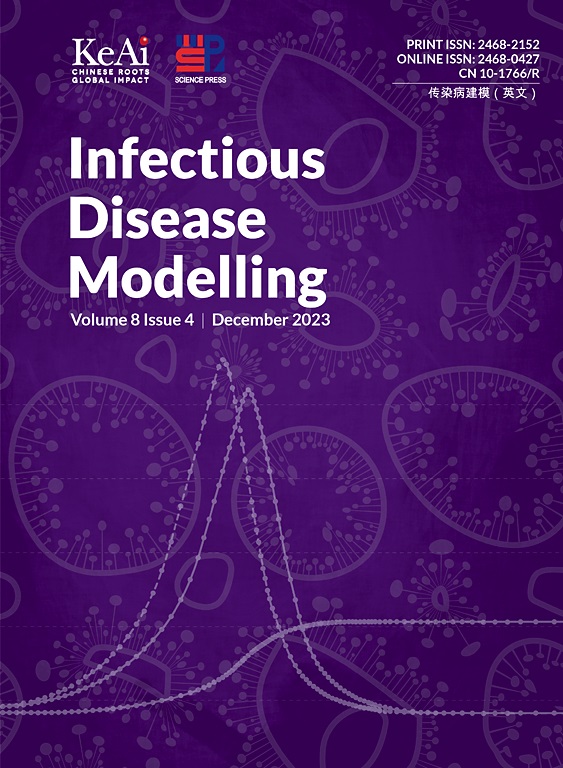Bayesian hierarchical modeling of Mpox in the African region (2022–2024): Addressing zero-inflation and spatial autocorrelation
IF 2.5
3区 医学
Q1 Medicine
引用次数: 0
Abstract
Mpox remains a signi_cant public health challenge in endemic regions of Africa. Understanding its spatial distribution and identifying key drivers in high-risk countries is critical for guiding e_ective interventions. This study applies a Zero-Inated Poisson (ZIP) model with spatial autocorrelation to estimate the adjusted relative risk (RR) of Mpox incidence across 24 African countries, strati_ed by Human Development Index (HDI) levels. The model accounts for overdispersion and excess zeros by incorporating spatial random e_ects and socio-environmental covariates, and was validated through model diagnostics and sensitivity analysis, demonstrating robustness of results. Spatial analysis revealed substantial heterogeneity in Mpox incidence, with elevated risk in the Democratic Republic of Congo (DRC), Nigeria, and Central African Republic (CAR) persisting after covariate adjustment (p < 0:001). Higher HDI levels were inversely associated with Mpox risk, with HDI quintile Q4 (very high HDI) showing a signi _cant reduction (aRR = 0.431; 95 % CrI: 0.099{0.724). Protective factors in low-risk areas included increased life expectancy at birth (aRR = 0.768; 95 % CrI: 0.688{0.892), higher educational attainment (aRR = 0.774; 95 % CrI: 0.680{0.921), nonlinear increases in gross national income (GNI) per capita, and a greater density of skilled health workers (aRR = 0.788; 95 % CrI: 0.701{0.934). Conversely, higher urban density was associated with increased Mpox risk, underscoring the inuence of population clustering on transmission dynamics. Notably, statistically signi_cant elevated-risk areas persisted in endemic countries of Western and Central Africa after covariate adjustment (p < 0:001). In contrast, previously undetected risk emerged in parts of Southern and Eastern Africa post-adjustment, revealing latent patterns obscured in the crude analysis (p < 0:001). Exceedance probability maps identi_ed countries with P(RR > 1) > 0.9 as priority areas for intensi_ed surveillance and targeted intervention. These patterns were not fully explained by the included covariates, suggesting the inuence of unmeasured factors such as environmental and climate variability, zoonotic reservoirs, or human{animal interactions. Further research is needed to deepen understanding of Mpox epidemiology and support locally tailored interventions.
非洲地区Mpox的贝叶斯分层模型(2022-2024):解决零通货膨胀和空间自相关问题
在非洲流行区域,麻疹仍然是一项重大的公共卫生挑战。了解其空间分布并确定高风险国家的主要驱动因素对于指导有效的干预措施至关重要。本研究采用具有空间自相关的零化泊松(ZIP)模型,以人类发展指数(HDI)水平为分层,估计了24个非洲国家的m痘发病率调整后的相对风险(RR)。该模型考虑了空间随机效应和社会环境协变量对过分散和过零的影响,并通过模型诊断和敏感性分析进行了验证,证明了结果的稳健性。空间分析显示,麻疹发病率存在显著异质性,协变量调整后,刚果民主共和国(DRC)、尼日利亚和中非共和国(CAR)的风险持续升高(p < 0:01)。较高的HDI水平与m痘风险呈负相关,HDI五分位数Q4(非常高的HDI)显示显着降低(aRR = 0.431; 95% CrI: 0.099{0.724)。低风险地区的保护因素包括出生时预期寿命延长(aRR = 0.768; 95% CrI: 0.688{0.892)、受教育程度较高(aRR = 0.774; 95% CrI: 0.680{0.921)、人均国民总收入(GNI)的非线性增长以及熟练卫生工作者的密度较高(aRR = 0.788; 95% CrI: 0.701{0.934)。相反,较高的城市密度与m痘风险增加相关,强调了人口聚集对传播动态的影响。值得注意的是,在协变量调整后,在西非和中非的流行国家中,具有统计学意义的高风险地区持续存在(p < 0:001)。相比之下,调整后非洲南部和东部部分地区出现了以前未被发现的风险,揭示了原始分析中隐藏的潜在模式(p < 0:01)。超出概率图将P(RR > 1) >; 0.9的国家确定为加强监测和有针对性干预的重点地区。这些模式不能被纳入的协变量完全解释,这表明环境和气候变异、人畜共患病宿主或人与动物相互作用等未测量因素的影响。需要进一步研究以加深对麻疹流行病学的了解并支持适合当地的干预措施。
本文章由计算机程序翻译,如有差异,请以英文原文为准。
求助全文
约1分钟内获得全文
求助全文
来源期刊

Infectious Disease Modelling
Mathematics-Applied Mathematics
CiteScore
17.00
自引率
3.40%
发文量
73
审稿时长
17 weeks
期刊介绍:
Infectious Disease Modelling is an open access journal that undergoes peer-review. Its main objective is to facilitate research that combines mathematical modelling, retrieval and analysis of infection disease data, and public health decision support. The journal actively encourages original research that improves this interface, as well as review articles that highlight innovative methodologies relevant to data collection, informatics, and policy making in the field of public health.
 求助内容:
求助内容: 应助结果提醒方式:
应助结果提醒方式:


